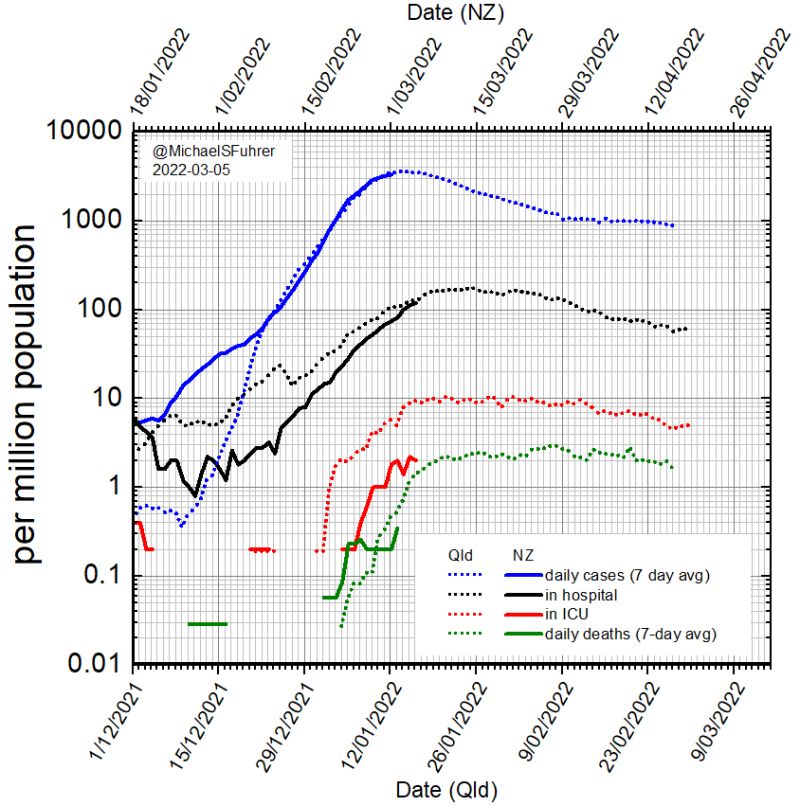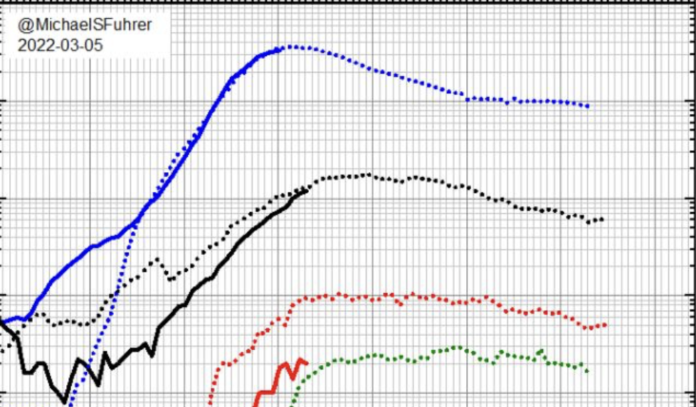Martin Jenkins consultancy director Nick Davis continues to produce interesting and relevant data on Covid-19 pandemic trends. This is even more so when they provide insights into what is happening or might happen in Aotearoa New Zealand.
He has done it again on the issue of when the Omicron variant might peak here Queensland and New Zealand.This is done by comparing New Zealand with Australia’s third most populous state, Queensland.
Why compare Queensland with New Zealand
New South Wales and Victoria have bigger populations. For different reasons (the former through vacillating political leadership and the latter through a long shared border with NSW and earlier lockdown fatigue), both states were overrun by the deadly Delta variant.
In contrast, as with the rest of Australia (and New Zealand), Queensland followed a successful elimination (zero tolerance) of community transmission strategy. Further, Queensland’s population (5.2 million) is only slightly higher than New Zealand’s.
But the high transmissibility of Omicron meant that the elimination strategy lost its effectiveness leaving mitigation the only realistic alternative. Queensland has far more deaths (over 590) and lower fully vaccination rate for its eligible population (91%) compared with New Zealand (under 70 and 96% respectively).
Queensland has also been disadvantaged by a long shared border with New South Wales (its mortality rate has rocketed since Omicron). Omicron also hit it earlier than New Zealand (whacked might be a more appropriate description).
A revealing graph
Davis has republished data comparing Queensland and New Zealand covering infection cases, hospitalisation, intensive care admissions and deaths. With the daily rate of infections in New Zealand now dropping, this might suggest that we have already peaked.
This is where I disagree with Davis. In my view this would be a premature assessment because of the greater proportion of asymptomatic cases under Omicron and underreporting due to the greater reliance on self-reporting due to the latest variant’s higher transmission. Davis does acknowledge this.
For me hospitalisations are a much more reliable indicator followed by intensive care admissions and deaths. This is where his insightful graph fits in.

Davis concludes that to date Aotearoa is “tracking fairly closely” to Queensland’s Omicron outbreak. He may be premature in respect of daily infections but the torch should be shone on hospitalisations in particular. They lag behind infection cases by at least a week.
What might we expect
He anticipates that if we follow Queensland’s experience there could be an almost doubling still to go in hospitalisations. Consequently, he argues, daily admissions might continue to grow for at least another one to two weeks (ie, public hospitals will come under much more pressure over the two to three weeks at least).
Interestingly Davis’ thoughts are broadly consistent with the cautious advice of University of Otago epidemiologists who suggest the hospitalisation peak might be over 1,100.
Pressure on hospitals will be further worsened by increasing staff off sick or isolating. This is a feature of the economy as a whole as witnessed today by the cancelled Inter-islander ferry for passengers.
But hospitals are among, if not the most vulnerable workplaces for staff illness. Further, public hospitals are the biggest workplaces within the geographic boundaries of district health boards that they are based in. As Davis correctly observes it is going to be very tough for patients and hospital staff.
New Zealand’s internationally high vaccination rates and timely booster shots have helped. Davis notes that how the country performs will depend on infection rates remain low amongst older age groups and other vulnerable more susceptible populations, and how well boosters work in preventing serious illness.
Boosters do appear to be effective but for how long is less clear. Fortunately New Zealand had higher booster take-up compared with Australia when Omicron first arrived on its shores.
Fingers crossed but perhaps we can come out of Omicron better than Queensland which itself has performed much better than the two most populated Australian states. That is, if our hospitalisation peak is reached in around two or three weeks.
Ian Powell was Executive Director of the Association of Salaried Medical Specialists, the professional union representing senior doctors and dentists in New Zealand, for over 30 years, until December 2019. He is now a health systems, labour market, and political commentator living in the small river estuary community of Otaihanga (the place by the tide). First published at Otaihanga Second Opinion






“For different reasons (the former through vacillating political leadership and the latter through a long shared border with NSW and earlier lockdown fatigue), both states were overrun by the deadly Delta variant.”
So nothing to do with NSWs higher density population, including lots of apartment dwelling and the earlier arrival of a plague ship in the form of the Ruby Princess?
What interesting stuff here. Especially this:
But the high transmissibility of Omicron meant that the elimination strategy lost its effectiveness leaving mitigation the only realistic alternative. Queensland has far more deaths (over 590) and lower fully vaccination rate for its eligible population (91%) compared with New Zealand (under 70 and 96% respectively).
Queensland has also been disadvantaged by a long shared border with New South Wales (its mortality rate has rocketed since Omicron). Omicron also hit it earlier than New Zealand (whacked might be a more appropriate description).
The comparison of deaths – over 590 and under 70 for NZ – is startling. So shove that where the sun don’t shine all those complaining about mandates. (That reminds me of the sexist language makeover done by Ronald Searle tongue-in-cheek. He would have swooped on mandate – turned it to womandate!). It’s time to relax and have a (quick) laugh if the figures show a real trend. Be quick though in case the buggies are brewing up another hell’s mix.
Yes exactly and add in Hong Kongs Covid response and it really does not look good for the anti mandate brigade.